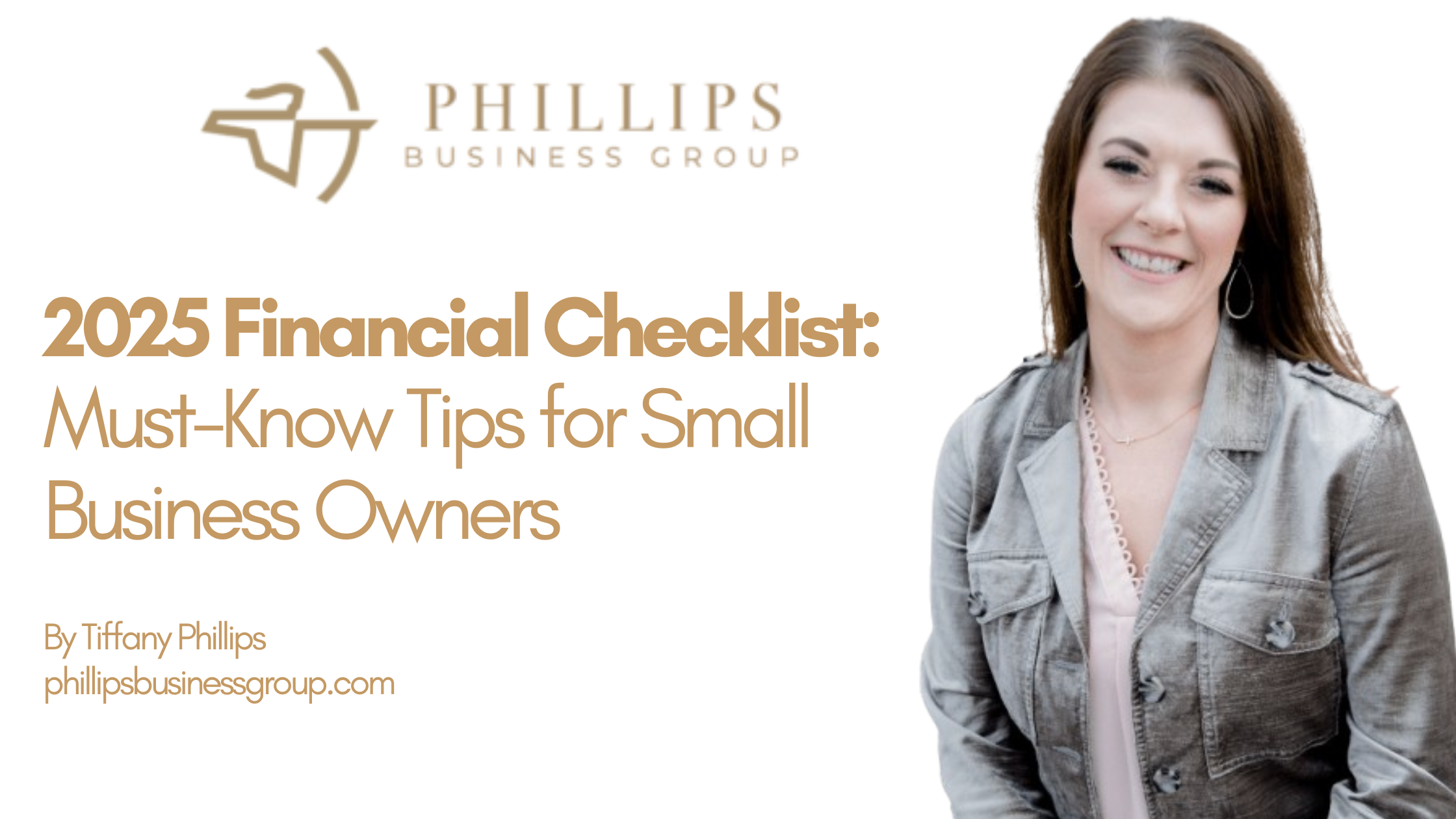Running a small business is no walk in the park. Between keeping clients happy, managing expenses, and dealing with the IRS, it can feel like you’re pouring your heart into your work just to hand over a huge chunk of your profits to Uncle Sam. As the year progresses, having a 2025 financial checklist can help ensure you’re making the most of available incentives. But here’s the thing: the IRS actually wants you to pay less in taxes. Crazy, right? The tax code is loaded with incentives that most business owners miss out on.
I’m Tiffany, and I’ve helped countless entrepreneurs turn financial overwhelm into clarity. One of my clients, Michael, a marketing agency owner, saved $48,000 in taxes last year using the checklist I’m sharing with you today. Best of all, it was completely legal and by the book. Whether you’re a solopreneur or leading a growing team, this 2025 financial checklist will help you keep more of your hard-earned money and set your business up for success. Grab a notebook, pour some coffee, and let’s get started!
Why 2025 Is a Game-Changer for Your Business Finances
The financial landscape in 2025 is unique. Interest rates have stabilized after the wild swings of 2023 and 2024, but they’re still higher than we’d like, making business loans and lines of credit more expensive. Inflation is down to about 2.8% annually, but it’s still creeping up, quietly raising your costs.
The Tax Relief for American Families and Workers Act passed this year brings some exciting changes for small business owners. From immediate R&D deductions to an expanded child tax credit, 2025 is a golden opportunity for strategic financial planning. But these breaks won’t last forever—some are set to expire in 2026, so you need to act fast.
Here are the nine steps every small business owner needs to take in 2025 to save money, improve cash flow, and secure a stronger financial future.
Step 1: Audit Your Business Structure
When you launched your business, you might have started as a sole proprietor or formed an LLC. But as your revenue grows, your business structure needs to evolve. Sticking with an outdated setup could cost you big time.
Take my client Robert, who ran a digital marketing agency as an LLC with $250,000 in annual profits. He was hit with self-employment tax on every dollar—15.3% on top of his income tax. We switched him to an S corporation, where he paid himself a reasonable salary and took the rest as distributions, saving over $22,000 in self-employment taxes in one year. That cash went toward hiring a new team member, fueling even more growth.
Action Step: Meet with a tax professional to review your business structure. Ask if an S corp, C corp, or another entity fits your current revenue and goals.
Step 2: Dig Into Your Profit and Loss Statement
Your profit and loss statement (P&L) is like a roadmap of your business’s financial health. Reviewing it regularly can reveal hidden issues or opportunities. Focus on these metrics:
- Gross Profit Margin: Are your pricing and costs in balance?
- Operating Expenses as a Percentage of Revenue: Is overhead eating into your profits?
- Net Profit Margin: Is your business model sustainable?
Watch for red flags like sudden cost increases or shrinking margins. Use your P&L to forecast the rest of 2025 and check if you’re on track for your goals.
Action Step: Pull your P&L for the first half of 2025. If it feels overwhelming, get a bookkeeper or CPA to help you analyze it.
Step 3: Check Your Tax Withholdings and Estimated Payments
If you’re making quarterly estimated tax payments, you could be overpaying or risking IRS penalties for underpaying. Many CPAs use a basic formula: last year’s income divided by four. But if your business is seasonal, this can mess with your cash flow.
The annualized income method lets you base payments on your actual income each quarter. I helped a retail client who earned 60% of her profits in the holiday season. By using this method, we cut her Q1–Q3 payments, keeping more cash in her business during slow months. She paid more in Q4, but the total tax bill didn’t change.
To avoid penalties, pay either 90% of this year’s tax or 100% of last year’s (110% if your income exceeds $150,000).
Action Step: Review your estimated payments for 2025. If your income fluctuates, ask your CPA about the annualized income method.
Step 4: Master Strategic Tax Planning
Strategic tax planning is where you can save serious money. Here are two powerful strategies for 2025:
- Augusta Loophole: If you use your home for business, you can rent it to your business for up to 14 days a year without reporting the rental income on your personal taxes. A client rented her home for board meetings at $500/day, earning $7,000 tax-free while her business claimed a deduction. Document everything—photos, logs, and a rental agreement.
- Vehicle Deductions: The 2025 standard mileage rate is 67 cents per mile, but the actual expense method might save more for larger vehicles. You can also deduct vacation expenses if the trip is primarily for business. A client deducted airfare and part of her hotel and meals for a conference trip with two personal days.
Action Step: Talk to your CPA about the Augusta loophole, vehicle deductions, or other tax-saving strategies for your business.
Step 5: Nail Cash Flow Management
Your bank balance isn’t the full story. A big balance doesn’t mean your business is profitable or ready for next month’s expenses. I worked with a construction company that had $200,000 in the bank but faced a cash crisis due to upcoming costs.
A 13-week cash flow forecast maps out your inflows and outflows, helping you spot crunches early. You can speed up client payments or negotiate vendor terms to stay afloat. Keep six to nine months of expenses in a high-yield savings account, separate from your operating account.
Action Step: Create a 13-week cash flow forecast using a spreadsheet or accounting software. Review it weekly.
Step 6: Boost Your Retirement Planning
Business owners have access to retirement plans that let you save more than employees. A solo 401(k) allows up to $23,000 in employee contributions (plus $7,500 if over 50) and 25% of compensation as the employer, totaling $69,000 in 2025. SEP IRAs and SIMPLE IRAs have different limits.
A doctor client sheltered $150,000 using a solo 401(k) and defined benefit plan, saving $55,000 in taxes while growing his retirement nest egg.
Action Step: Explore retirement plan options. If you have employees, consider a SIMPLE IRA for easier administration.
Step 7: Time Your Expenses Smartly
Should you push expenses into 2025 or defer income to 2026? If you’ll be in the same or higher tax bracket, take deductions now and delay income. In December, prepay expenses like insurance premiums or software renewals. A client saved $11,000 in taxes by shifting $30,000 in deductions to December.
Don’t buy unnecessary things or drain your cash reserves. Document the business purpose for each expense.
Action Step: In November 2025, check your tax bracket and cash flow. List deductible expenses to prepay by year-end.
Step 8: Plan for Employees and Contractors
For independent contractors, verify your W-9s for accurate 1099s. Instead of cash bonuses with high tax withholding, consider HSA contributions or paid time off for employees.
Hiring your kids? Those under 18 can earn up to $14,600 tax-free in 2025, with no payroll taxes. A client paid her teens $12,000 each for social media and admin work, shifting $24,000 from her taxable income.
Action Step: Update W-9s and rethink bonus strategies. Explore tasks for your kids to do in your business.
Step 9: Prep Financial Systems for 2026
Streamline your bookkeeping at year-end. If you’re stuck on spreadsheets, upgrade to accounting software like QuickBooks or Xero. Apps like Expensify or ReceiptBank make capturing receipts easy, ensuring you don’t miss deductions.
Stay ahead of 2026 tax changes, as some Tax Cuts and Jobs Act provisions expire. Plan now to minimize the impact.
Action Step: Try a new bookkeeping tool in December. Follow a tax news source for 2026 updates.
Dodge These 3 Wealth Villains
Even a solid financial plan can get tripped up:
- Keeping Up With the Joneses: Don’t copy competitors by leasing fancy offices or hiring unnecessary staff. A client nearly went bankrupt chasing appearances. Focus on your numbers.
- Ignoring Tax Planning: Most CPAs focus on compliance, not strategy. A client cut his $100,000 tax bill by 33% with proactive tax planning.
- Procrastination: “I’ll do it later” costs money. A client lost $45,000 in savings by delaying retirement planning. Start one checklist step today.
Own Your Financial Future
Last year, I worked with two business owners in the same industry with similar revenues. One used these strategies, saving $42,000 in taxes and building cash reserves. The other didn’t and is still grappling with cash flow and big tax bills. The difference? Action.
You don’t need to tackle everything at once. Pick one step from this checklist and start now. Small steps compound like interest in a savings account. For more, grab my free book, Your Biggest Expense: How to Legally Pay Less in Taxes and Keep More Wealth, at yourbiggestexpense.com. You’ll also get a mini-course with 85 tax strategies, a tax bonus guide, and an audio course on audit-proofing your taxes.
Don’t wait until December—2025’s opportunities are slipping away. Visit yourbiggestexpense.com today and take charge of your small business finances.
Listen to the Full Episode
To hear my most recent podcast on Spotify – click here!
To hear my most recent podcast on ApplePodCast– click here!


